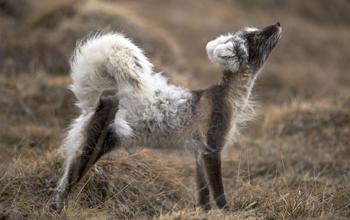Multimedia Gallery
Ecological consequences of sea-ice decline (Image 7)
An arctic fox. Records show that arctic sea ice is at its lowest point in 1,500 years and continues to melt at an accelerated rate. In fact, over the past several decades the Arctic has warmed at twice the global rate. Researchers are studying how ecological communities in the Arctic may be affected by its continued and even accelerated melting over the next decades. (Date of Image: May 2012-2013) [Image 7 of 13 related images. See Image 8.]
More about this image
Eric Post, a professor of biology at Penn State University, and an international team of scientists are examining how melting sea ice is affecting aquatic species like algae, plankton and whales, as well as land animals that live near the ice such as caribou, arctic foxes and walrus. They are also examining the effects of human exploration in areas of the region that were not previously accessible to humans.
"Arctic sea ice should be thought of as a biome or an ecosystem, and the effects of melting and warming on microorganisms living under ice in this biome already have received much attention, however, those animals living near the ice likely are feeling the effects as well," says Post. "Over the entire period covered by the record, arctic sea ice has declined by more than 86,000 square kilometers--a space slightly larger than the state of South Carolina--per year."
Post says the melting sea ice could have a domino effect, not only impacting sea life but disrupting the food chain for land-dwelling animals. Sea-ice algae and sub-ice plankton have already been greatly affected by melting sea-ice. This loss of ice has triggered a major change in their blooming times. Together, these two organisms account for 57 percent of the total annual biological production in the Arctic Ocean. In turn, land near areas with sea-ice loss will also be affected, experiencing significant surface warming inland from the coastline that will affect soil conditions and plant growth. Post and his colleagues hypothesize that, while invertebrate ocean-dwelling animals such as zooplankton that feed on algae and phytoplankton in the seas are already being affected, larger terrestrial animals such as caribou could find their land-dwelling food sources disrupted as well due to temperature changes affecting plant communities inland.
Other possible effects--both direct and indirect--of sea-ice loss and longer ice-free seasons on land animals include increases in population mixing, which could lead to hybridization and reduction in genetic differentiation, as well as a drastic change in disease dynamics; crowding of animals such as walrus in coastal habitats, leading to an increase in local population density that could result in transmission of pathogens and trampling of young; and development of shipping lanes and increased shipping traffic in areas previously rather inaccessible to humans, resulting in accelerated mineral and petroleum exploration that could affect both land and marine animals such as bowhead whales and Pacific walrus.
To read more about this research, funded by the National Science Foundation and also, in part, by the Polar Center at Penn State through the Penn State Institutes of Energy and the Environment, see the Penn State news story Arctic Sea-Ice Loss Has Widespread Effects on Wildlife.
Credit: Jeff Kerby, Eric Post lab, Penn State University
See other images like this on your iPhone or iPad download NSF Science Zone on the Apple App Store.
Images and other media in the National Science Foundation Multimedia Gallery are available for use in print and electronic material by NSF employees, members of the media, university staff, teachers and the general public. All media in the gallery are intended for personal, educational and nonprofit/non-commercial use only.
Images credited to the National Science Foundation, a federal agency, are in the public domain. The images were created by employees of the United States Government as part of their official duties or prepared by contractors as "works for hire" for NSF. You may freely use NSF-credited images and, at your discretion, credit NSF with a "Courtesy: National Science Foundation" notation.
Additional information about general usage can be found in Conditions.
Also Available:
Download the high-resolution JPG version of the image. (9 MB)
Use your mouse to right-click (Mac users may need to Ctrl-click) the link above and choose the option that will save the file or target to your computer.

